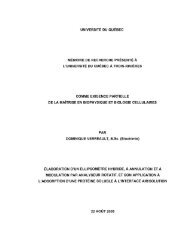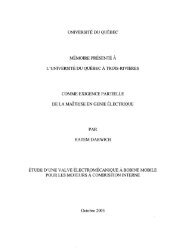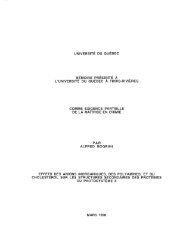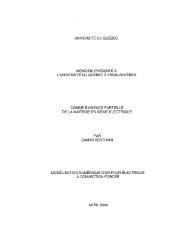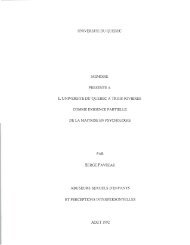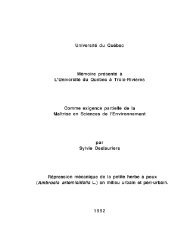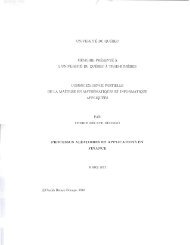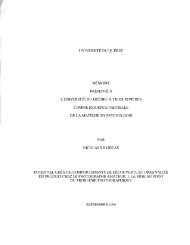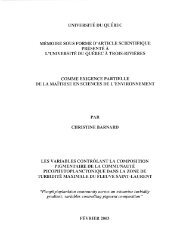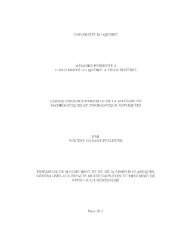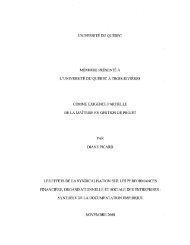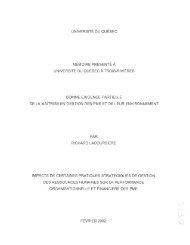- Page 1 and 2:
UNIVERSITÉ DU QUÉBEC THÈSE PRÉS
- Page 3 and 4:
UNIVERSITÉ DU QUÉBEC À TROIS-RIV
- Page 5 and 6:
La stratégie de recherche qUI rép
- Page 7 and 8:
T ABLE DES MATIÈRES SOMMAIRE .....
- Page 9 and 10:
1.7. STRUCTURES ...................
- Page 11 and 12:
3.10. LE CONTRÔLE ................
- Page 13 and 14:
6.2. LA ViSiON ....................
- Page 15 and 16:
3.2. CAS À SUCCÈS: COURT/SAGE ...
- Page 17 and 18:
7.5. CAS À ÉCHEC: PRÉCOURTISAGE
- Page 19 and 20:
11.1.2. Aspect multidimensionnel ..
- Page 21 and 22:
ANNEXE A TABLEAUX .................
- Page 23 and 24:
LISTE DES FIGURES 1. Phases du proc
- Page 25 and 26:
REMERCIEMENTS De nombreuses personn
- Page 27 and 28:
INTRODUCTION La globalisation des m
- Page 29 and 30:
La présente recherche trouve son o
- Page 31 and 32:
PREMIER CHAPITRE: PROBLÉMATIQUE ET
- Page 33 and 34:
Malgré ce passé riche en fl a, et
- Page 35 and 36:
Selon Rousseau (1990), des problèm
- Page 37 and 38:
s'avère pourtant essentielle puisq
- Page 39:
DEUXIÈME CHAPITRE: CONTEXTE THÉOR
- Page 42 and 43:
plusieurs auteurs traitent des dive
- Page 44 and 45:
Figure 3 - Phases du processus de f
- Page 46:
organisation industrielle. Ceux-ci
- Page 49 and 50:
Deuxièmement, il ressort que l'éc
- Page 54 and 55:
Auteurs Fowler et Schmidt (1988) He
- Page 56 and 57:
d'une fusion, en plus d'assurer une
- Page 58 and 59:
le moins que l'on puisse faire pour
- Page 62 and 63:
Selon Blake et Mouton (1984-1985),
- Page 64: climat de coopération. La capacit
- Page 69 and 70: ces dernières peuvent augmenter co
- Page 71: affecte les perceptions, les jugeme
- Page 75 and 76: succès de la fla (Graves, 1981; Sc
- Page 79 and 80: Auteurs Byers (1997) Larsson et Ris
- Page 81 and 82: 1.8.1 La stratégie, un peu d'histo
- Page 83 and 84: Ansoff en intégrant à la fois les
- Page 85 and 86: 4. Le système d'actions a pour obj
- Page 87 and 88: formulation, qu'il associait à un
- Page 89 and 90: Avant de présenter le cadre opéra
- Page 94 and 95: Voici ces biais cognitifs: 1. Le ra
- Page 96 and 97: Enfin, le processus de prise de dé
- Page 99: (1981) mettent l'accent sur l'analy
- Page 104 and 105: mises en œuvre et surtout, d'être
- Page 107 and 108: 2.1 Les dimensions séquentielles d
- Page 109 and 110: financières, il est fréquent de v
- Page 111 and 112: généralement chez les principaux
- Page 113 and 114: TROISIÈME CHAPITRE: CADRE OPÉRATO
- Page 118: d'intérêts pour notre recherche s
- Page 121 and 122: commande que cadre de référence t
- Page 123: 122 Au sujet de la taille de l'éch
- Page 126 and 127: 4.3. Le choix des intervenants En s
- Page 128 and 129: 127 Afin de mieux répondre à nos
- Page 130 and 131: plus locaux et informels des proces
- Page 132 and 133: documents additionnels comportant d
- Page 134 and 135: mémoire et nous ont permis d'élab
- Page 136 and 137: de dégager un ensemble de caracté
- Page 138 and 139: 5.4.3. Fiabilité 137 Dooley (1995)
- Page 140 and 141: Les chercheurs doivent avoir une co
- Page 142 and 143: 1. CAS F ASIDO 141 Fasido, c'est le
- Page 144 and 145: 1.2. Vision 1.2.1. Synergies antici
- Page 146 and 147: parce que les procédures de vérif
- Page 148 and 149: penms d'anticiper en amont plusieur
- Page 150 and 151: partir d'une analyse de l'environne
- Page 152 and 153: gestionnaires, il est important de
- Page 154 and 155: d'équipe, une prise de décision r
- Page 156 and 157: suite le contenu et le profil des p
- Page 158 and 159: 157 d'assurer la communication ponc
- Page 160 and 161: 1. 7.3. Résultats 159 Pour les hau
- Page 162 and 163: l'aide du tableau 14 présenté à
- Page 164 and 165: l'intégration, accordé une import
- Page 166 and 167:
augmentation d'efficacité envisag
- Page 168 and 169:
collaborateurs, ont créé une dyna
- Page 170 and 171:
anticipées et les autres objectifs
- Page 172 and 173:
de dollars de synergIes au sem de s
- Page 174 and 175:
1.11.4. Pour les clients 0 173 Fasi
- Page 176 and 177:
surface de plus de 10000 mètres ca
- Page 178 and 179:
2.2.3. Résultats 177 La similarit
- Page 180 and 181:
entrevues ont aussi été effectué
- Page 182 and 183:
gestionnaires) répondre au mieux
- Page 184 and 185:
2.5.3. Résultats 183 La fusion ave
- Page 186 and 187:
appartenait à Bêta. Ces dernière
- Page 188 and 189:
2.7. Les structures 2. 7.1. Synergi
- Page 190 and 191:
189 Le nouvel orgamgramme, connu as
- Page 192 and 193:
organisait et planifiait les travau
- Page 194 and 195:
193 Ainsi, une des premières chose
- Page 196 and 197:
La culture d'Alpha- était celle d'
- Page 198 and 199:
l'intégration a été affectée pa
- Page 200 and 201:
199 Cette unification a commencé p
- Page 202 and 203:
les prévisions ont été revues à
- Page 204 and 205:
203 Les fortes preSSIOns concurrent
- Page 206 and 207:
3.2.3. Résultats 205 L'implantatio
- Page 208 and 209:
3.3.2. Synergies implantées 207 Ma
- Page 210 and 211:
Réco- avaient alors conscience que
- Page 212 and 213:
3.5.2. Synergies implantées suivan
- Page 214 and 215:
courbe de perfonnance de l'industri
- Page 216 and 217:
On raisonnait ainsi: si on transfè
- Page 218 and 219:
secteurs d'intérêt commun où ils
- Page 220 and 221:
3.8.2. Synergies implantées 219 De
- Page 222 and 223:
a été synergIque, car ils ont pns
- Page 224 and 225:
intégrations et s'est déroulée d
- Page 226 and 227:
Le nouveau système infonnatique no
- Page 228 and 229:
227 3. Très peu d'emplois ont ét
- Page 230 and 231:
4.2. La vision 4.2.1. Synergies ant
- Page 232 and 233:
eaucoup à établir un niveau de sy
- Page 234 and 235:
associés à cette dimension. ABC+
- Page 236 and 237:
4.6. La stratégie d'affaires 4.6.1
- Page 238 and 239:
237 L'intégration des stratégies
- Page 240 and 241:
4.8. Fonctions 4.8.1. Synergies ant
- Page 242 and 243:
4.9.2. Synergies implantées 241 Au
- Page 244:
décidé de garder les deux systèm
- Page 247 and 248:
5.1. Contexte concurrentiel 246 Dep
- Page 249 and 250:
devenir une division de Romulus. «
- Page 251 and 252:
5.3. Le diagnostic 5.3.1. Synergies
- Page 253 and 254:
gestionnaires affirment que, durant
- Page 255 and 256:
5.4. L'environnement 5.4.1. Synergi
- Page 257 and 258:
256 l'atteinte d'une masse critique
- Page 259 and 260:
commun de l'outil industriel) et de
- Page 261 and 262:
Développement, le président de Ro
- Page 263 and 264:
5.8. Les fonctions 5.8.1. Synergies
- Page 265 and 266:
5.8.3. Résultats 264 Le chef de l'
- Page 267 and 268:
266 Selon d'autres dirigeants, les
- Page 269 and 270:
cela ralentirait la vitesse d'innov
- Page 271 and 272:
certaines initiatives et décisions
- Page 273 and 274:
confirmait que:
- Page 275 and 276:
5.11.2. Résultats pour les hauts g
- Page 277 and 278:
276 A vec cette deuxième fusion, l
- Page 279 and 280:
6.3.2. Synergies implantées 278 Da
- Page 281 and 282:
6.4. Analyse de l'environnement 6.4
- Page 283 and 284:
6.5.2. Synergies implantées 282 Se
- Page 285 and 286:
6.6.3. Résultats 284 Selon des hau
- Page 287 and 288:
286 Monsieur Abé, dès le début,
- Page 289 and 290:
288 L'intégration supprimerait dan
- Page 291 and 292:
6.9. La culture 6.9.1. Synergies an
- Page 293 and 294:
292 La gestion de l'intégration cu
- Page 295 and 296:
fulgurants. Privés d'informations
- Page 297 and 298:
7.1. Présentation de Milado 296 Mi
- Page 299 and 300:
7.2.2. Synergies implantées 298 La
- Page 301 and 302:
300 La vision aurait dû, selon des
- Page 303 and 304:
différences au niveau culturel pou
- Page 305 and 306:
et Lado. Les prIX du papIer régres
- Page 307 and 308:
306 Les motifs discutés lors de la
- Page 309 and 310:
308 Pour d'autres, la trop grande c
- Page 311 and 312:
3]0 Les équipes de transition deva
- Page 313 and 314:
312 D'autres hauts dirigeants souli
- Page 315 and 316:
XY, comme ça. Vous les rencontrez,
- Page 317 and 318:
7.8.3. Résultats 316 Il semble, se
- Page 319 and 320:
connaIssances à contribution, nous
- Page 321 and 322:
Le facteur culturel s'est révélé
- Page 323 and 324:
une "prime-synergie". Tu peux inté
- Page 325 and 326:
324 3. Perte de clients au profit d
- Page 327 and 328:
8.3. Résultats Les résultats de c
- Page 330 and 331:
329 Dans le but de faire ressortir
- Page 332 and 333:
331 De plus, selon certains de ces
- Page 334 and 335:
étudiés, cela a été fait sans r
- Page 336 and 337:
3.5. Cas à échec: Courtisage 3.5.
- Page 338 and 339:
3.7.2. Absence de crédibilité et
- Page 340 and 341:
4. LE DIAGNOSTIC 339 En comparant l
- Page 342 and 343:
suivants font partie de la vérific
- Page 345 and 346:
4.5. Cas à échec: Précourtisage
- Page 347 and 348:
• Absence d' autodiagnostic. •
- Page 349 and 350:
5.2. Cas à succès: Courtisage 5.2
- Page 351 and 352:
• Bonne connaissance de l'environ
- Page 353 and 354:
5.5.2. Analyse trop ciblée 352 En
- Page 355 and 356:
354 Par exemple, les hauts gestionn
- Page 357 and 358:
et que cela avait aussi été bén
- Page 359 and 360:
6.5.2. Motifs cachés 358 L'étape
- Page 361 and 362:
• Motifs généraux • Motifs ca
- Page 363 and 364:
harmonisation des stratégies d'aff
- Page 365 and 366:
7.4.4. Harmonisation des stratégie
- Page 367 and 368:
des stratégies d'affaires pour le
- Page 369 and 370:
• Stratégies d'affaires connues
- Page 371 and 372:
d'entente, des attitudes de coopér
- Page 373 and 374:
la réalisation des synergIes. La v
- Page 375 and 376:
374 Dans les cas à succès, la str
- Page 377 and 378:
8.5.2. Structure à réduire 376 L'
- Page 379:
378 Dans ces cas à échec, la rés
- Page 382 and 383:
9.2. Cas à succès: Courtisage 9.2
- Page 384 and 385:
petite équipe bien soudée qui est
- Page 386 and 387:
9.3.3. Gestion rapide du "Je" 385 L
- Page 388 and 389:
• Importance des ressources humai
- Page 390 and 391:
9.6. Cas à échec: Vérification d
- Page 392 and 393:
9.7.5. Mauvaise communication 391 D
- Page 394 and 395:
• Compétences surestimées • S
- Page 396 and 397:
10.2. Cas à succès: Courtisage 1
- Page 398 and 399:
397 Dans ces entreprises, les leade
- Page 400 and 401:
10.4.5. Formation nécessaire 399 D
- Page 402 and 403:
10.5. Cas à échec: Précourtisage
- Page 404 and 405:
403 Dans les cas d'Abantel+ et de R
- Page 406 and 407:
• Culture mal connue • Priorit
- Page 408 and 409:
11.2. Cas à succès: Courtisage 11
- Page 410 and 411:
faire différentes et n'harmoniser
- Page 412 and 413:
411 Les comparaisons inter-cas à p
- Page 414 and 415:
ces cas, l'intégration des mesures
- Page 417 and 418:
Figure 29 - Effets synergiques des
- Page 421:
• Aspect unidimensionnel • Aspe
- Page 424 and 425:
succès reliés à chacune des dime
- Page 426 and 427:
négligent de gérer rapidement les
- Page 428 and 429:
diffusion adéquat, mais il dépend
- Page 430 and 431:
429 Ces résultats montrent que les
- Page 432 and 433:
majorité des cas, sur l'environnem
- Page 434 and 435:
que la vérification diligente des
- Page 436 and 437:
le plus. La figure 33 présente le
- Page 438 and 439:
aérien. Ils ont notamment oublié
- Page 440 and 441:
hauts gestionnaires des entreprises
- Page 442 and 443:
(1997) montre également qu'il est
- Page 444 and 445:
savoir-faire et des compétences de
- Page 446 and 447:
synergIque dont l'impact sur la per
- Page 448 and 449:
échec, les malaises et tensions cl
- Page 450 and 451:
et conduire à les analyser plus en
- Page 452 and 453:
qu 'un tel constat a pu se faire. D
- Page 454 and 455:
453 A contrario, l'intégration des
- Page 456 and 457:
455 Le recours à différents comit
- Page 458 and 459:
7.6. Composition et mandats des com
- Page 460 and 461:
des résultats des cas à succès,
- Page 462 and 463:
l'intégration culturelle. Il est f
- Page 464 and 465:
peuvent surgir, compromettant le su
- Page 466 and 467:
ne pennet pas d'identifier un mode
- Page 468 and 469:
467 Événements et cérémonies. O
- Page 470 and 471:
469 concret et visible semble favor
- Page 472 and 473:
des employés, au développement d'
- Page 474 and 475:
pleinement au système. Ils pouvaie
- Page 476 and 477:
perfonnance envisagée de façon mu
- Page 478 and 479:
477 Un leadership basé sur la conf
- Page 480:
capacité d'apprentissage et de par
- Page 503:
IV- Intégration (suite) INTÉGRATI
- Page 516 and 517:
IV- Intégration (suite) tégration
- Page 518 and 519:
combinées entre elles, permettaien
- Page 520 and 521:
1. IMPLICATION POUR LA RECHERCHE 51
- Page 523 and 524:
RÉFÉRENCES BIBLIOGRAPHIQUES Allai
- Page 525 and 526:
Berk, T.G. (1996). Sending the righ
- Page 527 and 528:
Burgelman, R. (1983). A model of th
- Page 529 and 530:
Cosh, A.D. et Guest, P.M. (2001). T
- Page 531 and 532:
Dranove, D. et Shanley, M. (1995).
- Page 533 and 534:
Gilkey, R. (1991). The psychodynami
- Page 535 and 536:
Haspelagh, P.c., et Jemison, D.B. (
- Page 537 and 538:
Jarrell, G.A., Brickley, J.A. et Ne
- Page 539 and 540:
Leana, C.R. et Feldman, D.C. (1989)
- Page 541 and 542:
Marks, M.L. (1982). Merging hum an
- Page 543 and 544:
Mintzberg, H. (1979). The structuri
- Page 545 and 546:
Palit, o. (1993). The Anglo-Saxon a
- Page 547 and 548:
Rousseau, L. (1990). L 'acquisition
- Page 549 and 550:
Smith G. D. (1985). The Anatomy of
- Page 551 and 552:
Westphal, T.G. et Shaw, V. (2005).
- Page 553 and 554:
Tableau 14 - Le processus de planif
- Page 555 and 556:
Sous-équipes d'intégration 554 Pa
- Page 557 and 558:
Figure 6 - Processus de sélection
- Page 559 and 560:
• Centralisation • Rétention r
- Page 561 and 562:
Annexe C Guide d'entretien
- Page 563 and 564:
9. Selon vous, quelles sont les res
- Page 565 and 566:
- Avez-vous remplacé vos politique
- Page 567 and 568:
Annexe D Perspective historique du
- Page 569:
stade de la sympathie, qUI consiste



